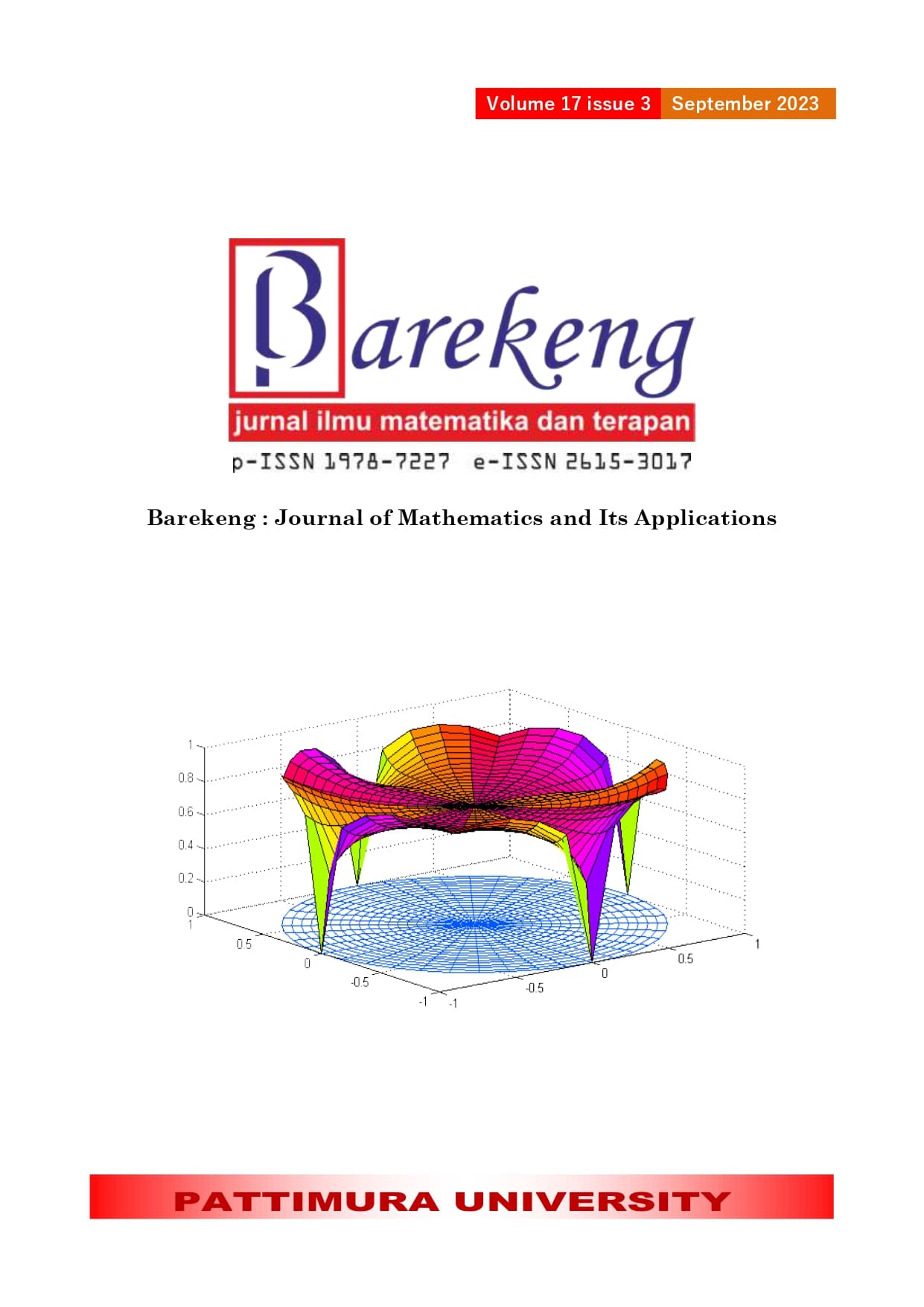SPATIAL MODELING IN DATA PANELS WITH LEAST SQUARE DUMMY VARIABLE TO IDENTIFY FACTORS AFFECTING UNEMPLOYMENT IN INDONESIA
Abstract
Unemployment is a serious issue that must be addressed. Unemployment has a negative impact on the national economy, making economic growth unpredictable. In 2015, Indonesia was ranked third with the highest unemployment rate in ASEAN. It is estimated that the unemployment rate in each province of Indonesia is influenced by the surrounding provinces. Therefore, spatial modelling on panel data with Least Square Dummy Variable (LSDV) is needed to identify factors that influence unemployment in Indonesia. The data used is Open Unemployment Rate (OUR) data and influencing factors are population, average length of schooling, Gross Regional Domestic Product (GRDP) rate, and Human Development Index (HDI) in 34 provinces of Indonesia from 2015 to 2020. Spatial model on panel data with appropriate LSDV for OUR data are Spatial Autoregressive Model (SAR) and Spatial Error Model (SEM). The SAR model with fixed effects has an value of 90.289%, which is greater than the SEM model with fixed effects (82.708%) and LSDV model (87.864%). The root mean square error value for SAR model with fixed effects is 0.58951, less than SEM model with fixed effects (0.78669) and LSDV model (0.65903). The best model is the SAR model with fixed effects. Based on this model, the factors that influence OUR in Indonesia from 2015-2020 are obtained, namely the rate of GRDP and HDI.
Downloads
References
E. Amalia and L. K. Sari, “Analisis Spasial untuk Mengidentifikasi Tingkat Pengangguran Terbuka Berdasarkan Kabupaten/Kota di Pulau Jawa Tahun 2017,” Indones. J. Stat. Its Appl., vol. 3, no. 3, pp. 202–215, 2019.
R. Ilahi, M. Syamsuddin, and Y. Suparman, “Model Spasial Durbin dengan Efek Tetap untuk Tingkat Pengangguran Terbuka di Provinsi Kepulauan Bangka Belitung,” pp. 1–12, 2014.
D. A. Arjun, Sifriyani, and Syaripuddin, “Analisis Faktor-Faktor Yang Mempengaruhi Menggunakan Regresi Nonparametrik Spline,” Pros. Semin. Nas. Mat. Stat. dan Apl., vol. 1, pp. 115–121, 2019.
J. Palindangan and A. Bakar, “Analisis Pengaruh Tingkat Pertumbuhan Ekonomi Dan Indeks Pembangunan Manusia (IPM) Terhadap Tingkat Pengangguran Di Kabupaten Mimika,” J. Krit. (Kebijakan, Riset, dan Inovasi), vol. 5, no. 1, pp. 65–80, 2021.
D. P. H. R. Handayani, “Analisis Pengaruh Jumlah Penduduk, Pendidikan, Upah Minimum, dan PDRB terhadap Tingkat Pengangguran Terbuka Di Provinsi Jawa Tengah,” Diponegoro J. Econ., vol. 1, no. 1, pp. 159–169, 2019.
J. P. Elhorst, Spatial Panel Data models. New York: Springer, 2010.
Ö. B. Soylu, İ. Çakmak, and F. Okur, “Economic growth and unemployment issue: Panel data analysis in Eastern European Countries,” J. Int. Stud., vol. 11, no. 1, pp. 93–107, 2018, doi: 10.14254/2071-8330.2018/11-1/7.
J. Brüderl and V. Ludwig, “Fixed-effects Panel Regression,” Regres. Anal. Casual Inference, no. 1, pp. 327–357, 2015.
G. K. Appiah, K. Prempeh, S. Benn, and E. Oduro, “Panel Data Analysis of Employment and Unemployment in Sub-Saharan Africa and Its Impact on Annual Percentage Change in GDP Growth,” Open Sci. J., vol. 5, no. 2, pp. 1–26, 2020.
R. Dubin, A. S. Fotheringham, and P. A. Rogerson, Spatial Weights. London: Sage Publications, 2009.
I. R. Hikmah and Y. Hikmah, “Pemodelan Spasial Data Panel Untuk Menentukan Faktor-Faktor Yang Mempengaruhi Kesehatan Di Provinsi Papua,” Statmat J. Stat. Dan Mat., vol. 2, no. 2, pp. 176–188, 2020.
T. Reydita, “Analisis Spasial Data Panel Pada Indeks Pembangunan Manusia Provinsi Jawa Barat dan Provinsi Banten,” 2020.
D. N. Gujarati and D. C. Porter, Basic Economentrics, Fifth Edit. New York, 2013.
C. Hsiao, Analysis of panel data, second edition. The Press Sindicate of the Universoty of Cambridge, 2014.
L. Anselin, Spatial Econometrics: Methods and Models. London, 1988.
L. Anselin, A. S. Fotheringham, and P. A. Rogerson, Spatial Regression. London: Sage Publications, 2009.
J. P. Elhorst, “Specification and estimation of spatial panel data models,” Int. Reg. Sci. Rev., vol. 26, no. 3, pp. 244–268, 2003.
T. Chai and R. R. Draxler, “Root Mean Square (RMSE or Mean Absolute Error (MAE) Arguments againts Avoiding RMSE in the Literature,” Geosci. Model Dev., vol. 7, no. 3, pp. 1247–1250, 2014.
B. H. Baltagi, Econometric Analysis of Panel Data, vol. 5, no. 7. 2005.
R. S. Bivand, E. J. Pebesma, and V. G. Rubio, Applied Spatial Data Analysis with R. New York: Springer, 2013.
C. F. Dormann et al., “Methods to account for spatial autocorrelation in the analysis of species distributional data : a review,” Ecography (Cop.)., pp. 609–628, 2007.
O. Babak and C. V. Deutsch, “Statistical approach to inverse distance interpolation,” Stoch. Environ. Res. Risk Assess., vol. 23, no. 5, pp. 543–553, 2009.
M. Mathur, “Spatial autocorrelation analysis in plant population: An overview,” J. Appl. Nat. Sci., vol. 7, no. 1, pp. 501–513, 2015.
J. P. Elhorst, “Dynamic Spatial Panels: Models, Methods and Inferences, ” Journal of geographical systems., vol. 14, no. 1, pp. 5-28, 2014.
Copyright (c) 2023 Sri Indriani Amil, Sri Astuti Thamrin, Siswanto Siswanto

This work is licensed under a Creative Commons Attribution-ShareAlike 4.0 International License.
Authors who publish with this Journal agree to the following terms:
- Author retain copyright and grant the journal right of first publication with the work simultaneously licensed under a creative commons attribution license that allow others to share the work within an acknowledgement of the work’s authorship and initial publication of this journal.
- Authors are able to enter into separate, additional contractual arrangement for the non-exclusive distribution of the journal’s published version of the work (e.g. acknowledgement of its initial publication in this journal).
- Authors are permitted and encouraged to post their work online (e.g. in institutional repositories or on their websites) prior to and during the submission process, as it can lead to productive exchanges, as well as earlier and greater citation of published works.






1.gif)



